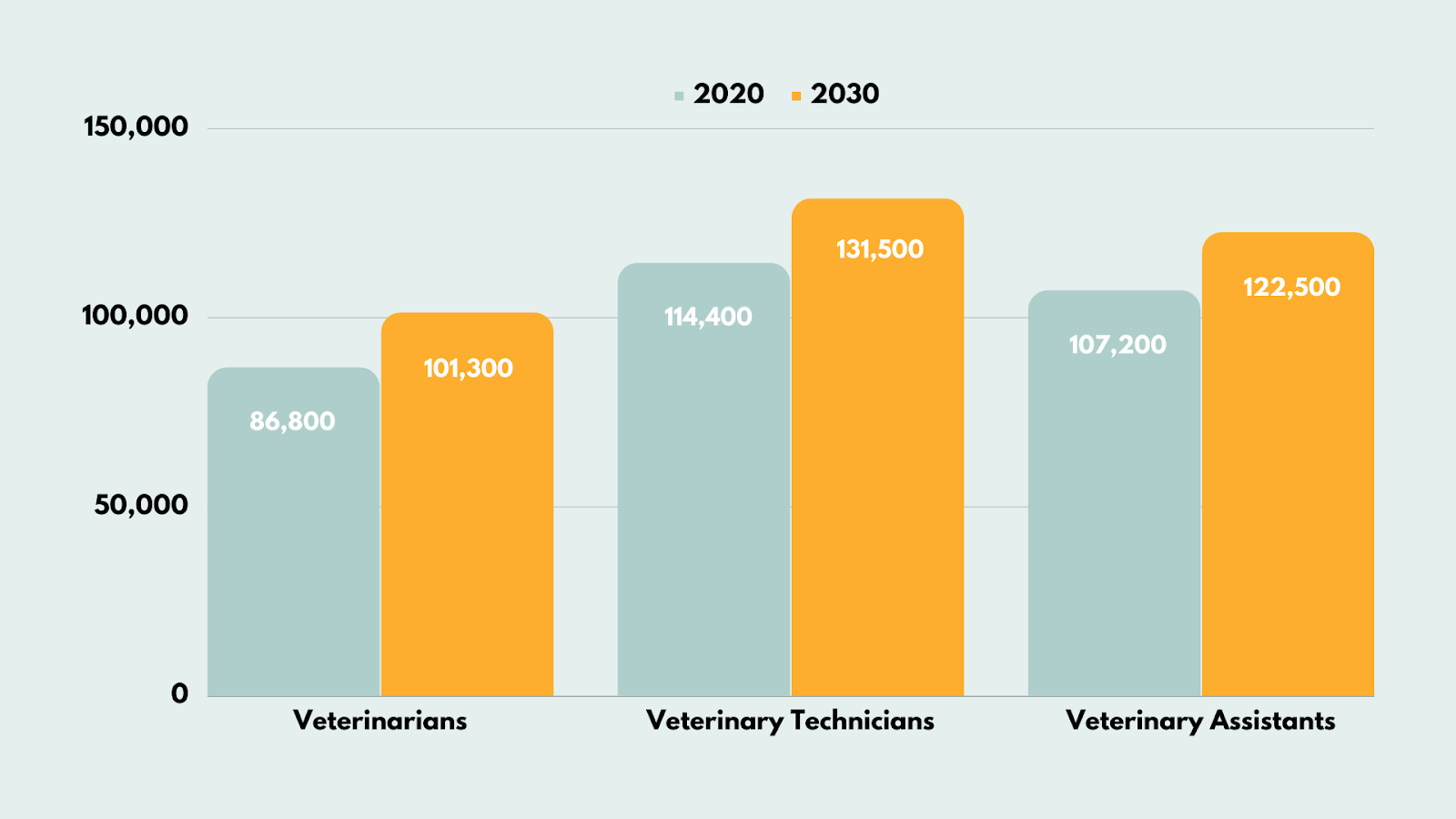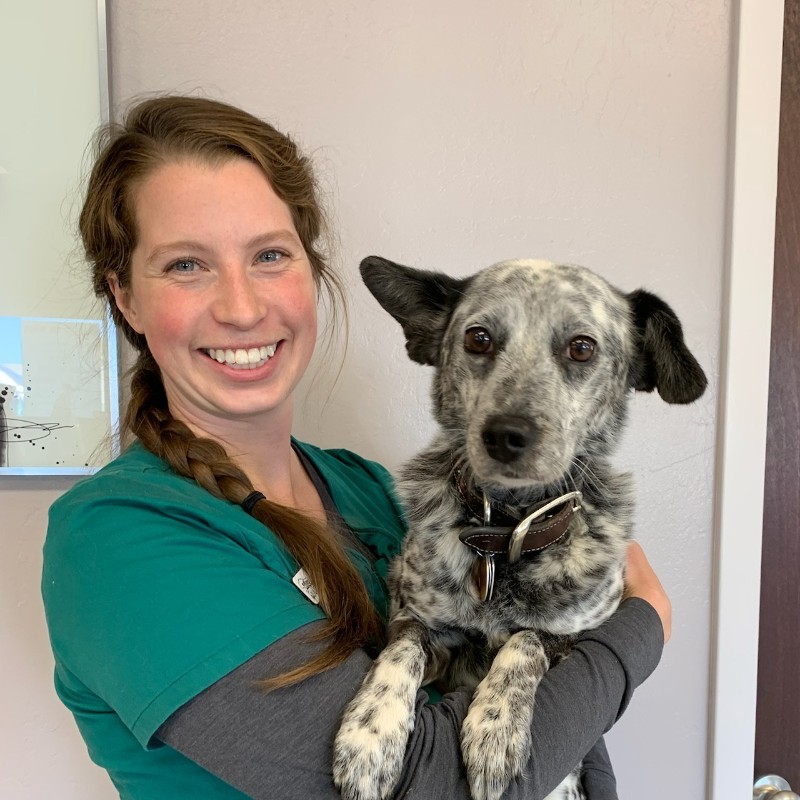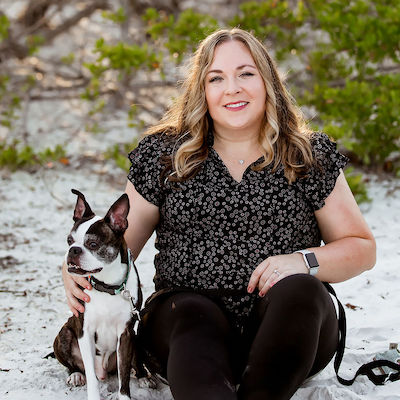table of contents
Comprehensive Candidate Journey1. Job Application
2. After Application
3. Interview Scheduling
4. Interview Experience
5. After Interview
6. Job Offer
7. Start Date
8. First Day
9. Process Feedback
Excellent Candidate Experience
Be Responsive
Be Transparent with Next Steps
Quantitative Evaluations
Get to Know Them
Why Should You Care About a People-First Recruitment Experience?
Veterinary medicine is in a hiring crisis.
According to the U.S. Bureau of Labor Statistics, vet med position needs are growing faster than the average across industries.
- For veterinarians, a growth rate of 17%, with 14,500 new positions by 2030
- For veterinary technicians, a growth rate of 15%, with 17,100 new positions by 2030
- For veterinary assistants, a growth rate of 14%, with 15,300 new positions by 2030

That’s nearly 50,000 new positions to fill in less than 10 years.
And that’s before we even talk about attrition rates in the industry — which only compound the full job boards we see across the country.
We are officially in a talent-constrained market, and the power of choice has shifted more control into the hands of job seekers.
They are now negotiating more heavily and refusing to settle for inadequate pay, unhealthy culture, and restrictive employment contracts.
(Which, to be clear, isn’t a bad thing.)
But, it does mean we as a profession have to evolve. We must be willing to center the candidates in our recruiting process to capture and attain the best talent for our practices.
So, we must put people first.
When we establish relationships early on that focus on people, rather than just filling a role, we create teams that are invested in what we’re building.
How You Can Be People-First in Recruiting:
Build a Comprehensive Candidate Journey
A people-first approach in recruiting is thinking through every touch point in the candidate journey with a strong emphasis on the candidate experience.
Every company needs to make the process (sourcing/application through onboarding) as seamless and personalized as possible.
Now more than ever, it’s important to modernize our people practices and meet individuals where they already are.
So, how do you create this comprehensive journey? Answer these 9 questions:
1. How do candidates find your job postings & apply?
Are you just posting on your careers page and hoping for the best? If so, here are the top 5 veterinary job sites you should be posting on:
- Scout by hound
- Indeed
- AVMA Veterinary Career Center
- AAHA Veterinary Jobs
- NAVC Retriever
Want the full details on each? Check out our full breakdown here.
2. How do candidates know what happens after applying?
Something as simple as setting up a quick, templated email can go a long way.
Both Gmail and Outlook provide email templates in their inboxes. This can streamline your workflow while ensuring you’re moving things forward with your candidates and providing them with an awesome experience.
Interested in trying it yourself? Feel free to copy/paste the template below:
Hey, {name}!
Thanks for applying to one of our open positions! We’ll review your application and get back to you within the next couple of days.
If you don’t hear back from us, feel free to pop a reply to this email to make sure we haven’t lost you in the mound of emails!
Talk to you soon!
{signature}
As a rule of thumb, a good follow-up email will include:
- Thank them personally for applying
- Give a clear timeline of when they can expect to hear back
- Provide a preferred way to reach out if you miss that deadline
Additionally, most Applicant Tracking Systems (ATS) have email triggers and different ways to notify candidates at each step of the process. If you don’t have an ATS, it might be worth checking one out!
3. How do candidates schedule & prepare for interviews?
Now you’re ready to bring them in for interviews!
Below, Kimberly Horn of Innovetive Pet Care provided a full checklist of items to consider when scheduling interviews:
- Schedule a time that is convenient for the candidate to come interview with you – you need to work around their schedule.
- Send itinerary in advance of the visit. Include attire, who they will be meeting with, what they will need to bring, time to arrive, and what to expect on the day of their visit.
- Ensure all necessary team members will be present, including practice leadership.
- Prepare questions and know your elevator speech.
- Inform your team of the visit to ensure everyone is aware and can welcome them.
- Have fun and think outside of the box.
- Make plans to do something nice for the time they are there, such as taking them to dinner or an event with members of your practice.
- Consider sending the candidate a small gift in anticipation of their visit. For gifts to make an impact, you do not have to spend a ton of money, but knowing your candidates allows you to give a personalized gift for a small amount of money that will have triple the impact.
Additionally, if the candidate is relocating:
- Ask the candidate if they would like to invite their significant other to come along on the visit and pay for their travel.
- Schedule an additional day to explore the area, look at houses, etc.
- Provide materials/information/resources for areas of interest, hot spots, local attractions, great places to dine, realtors, schools, etc.
4. What do the candidates experience at the interview?
Then, on the day of the interview, you want them to feel valued, included, and welcome.
Kimberly also came up with a comprehensive checklist for day-of logistics to consider as well:
- Put the candidate’s name up on the board to welcome them.
- Introduce the candidate to the team.
- Encourage all employees to greet and interact with the candidate.
- Be prepared to spend quality time with the candidate.
- Be energetic and positive.
- Talk about what is important to them, what they are looking for, and what excites them.
- Listen to what they are looking for and how that fits with your team.
- Ask engaging interview questions – use words and phrases that engage them.
- Rock your elevator speech – this is your time to brag about the fantastic things about your practice and all that it has to offer – make this an exciting talk.
- Talk about amazing things about your practice and why you love working there.
- Talk about what sets you apart from the rest.
When you’re wrapping up the visit:
- Make sure that the candidate doesn’t have any remaining questions.
- Ask them how they felt about the visit, the practice, the fit.
5. How long do the candidates wait to hear from you after an interview?
Again, this is where your email templates come in handy.
You can even schedule an email to send directly after the interview (Gmail and Outlook both provide the ability to do this). This is great if you have a full day of interviews or if you’re schedule is particularly busy that day.
Here’s a simple template below:
Hi {name}!
Thanks for coming in and meeting our team today! We had a blast getting to know more about you and your goals for your next role.
We have a few more interviews this week and should have a decision to you by Friday!
If you accept a competing offer or just don’t think our team is a fit for you, no hard feelings. :) Just drop a note to this email letting us know!
If you don’t hear back from us by Monday, feel free to reach out.
Talk to you soon!
{signature}
The keys to a good follow-up email at this stage are:
- Thank them personally for coming in.
- Give a clear timeline they can expect.
- Open the door for them to decline, saving you extra steps.
- Provide a way preferred way to reach out if you miss that deadline.
6. How do candidates know if they got the job?
At this step, it’s crucial to reach out to every person, whether they are receiving an offer or not. This leaves the door open for future positions or referrals from this person.
Again, Kimberly created a comprehensive list for both scenarios:
If you want to make an offer to the candidate…
- Acknowledge their time and experience.
- Tell them that you think that would be an excellent fit for the team. If you have created a meaningful journey for your candidate at this stage of the interview, they are feeling engaged and can envision themselves as a part of your team.
- Let them know you would love them to join the team, and you will be extending a formal offer.
- Put together a creative incentive plan for just them that allows them to live their best veterinary lifestyle.
If you do not want to make an offer…
- Thank them for spending time with you and your practice.
- Inform them you won’t be moving forward with them at this time, and provide a reason (other candidate had more experience, etc.).
- Ask them if they’d like to be considered for future opportunities.
- Get feedback on the interview process.
Regardless of whether you hire someone, they should all get the red-carpet treatment.
7. How do candidates know their start date & what to expect from their first day?
Determining a start date
When determining a start date, you should always take the new hire’s lead. Sometimes, they may want/need an extra week between jobs. Sometimes, they may not feel comfortable financially with that.
Want to make their experience awesome? Give them a paid week off before they start.
This gives those who may not feel as financially secure the ability to rest without feeling strained and starts your relationship off on the right foot.
Even if they were unemployed or in between jobs directly before this opportunity, interviewing and finding a job can be as stressful (if not more) than if they’re coming straight from another job.
What to expect on their first day
This can be summed up in a welcome email, and a follow-up call to personally tell them all the details.
Here’s a checklist to include in your email:
- when they’re supposed to show up
- what they should wear (is this a scrubs day or are they just doing paperwork?)
- what their day will consist of
- any paperwork or documentation they need to bring
- when they can expect to get off that day
This sets expectations early and makes sure they feel prepared and comfortable coming into their first day on the job.
8. How are candidates treated on their first day?
First impressions are everything. It’s what they’ll come back to when they think about their experience at your practice.
So, to make their first day awesome, it’ll take a little prep work.
Before their first day…
Get to know them!
Send them a quick survey asking them their favorites. Then, get them some goodies that match those!
Educate & excite the rest of the team
Make sure everyone on the team is just as excited as you are for this new hire! Hype them up and make sure everyone working their first shift knows them before they walk through the door.
On their first day…
Understand their working style. Doing this will ensure they feel valued and take constructive criticism well — making their experience at your practice better.
This includes 3 core areas:
- Communication: how do they prefer to receive and give feedback?
- Motivation: what motivates & encourages them to keep up the great work?
- Reward: how do they prefer to receive recognition?
Want more tips on making a new hire’s first day memorable?
Check out our blog for more actionable tips!
9. How can candidates give feedback on the recruitment process?
This is often overlooked, but it’s a crucial part of the process — and is essential to adapting & engaging your workforce.
Especially since most of us who run the interview process are:
- A practice manager who’s also chief of staff, HR, accounting, and every other operations position.
- A recruiter who is not in the practice every day to see what’s happening on the ground.
Meaning we often don’t have the full picture of the experience.
This can be a quick phone call or survey they fill out where you ask how the experience was, what they would change, and what step didn’t feel as smooth as the rest of the process.
Including the new hire in this process gives them a sense of ownership and helps us recruit even better candidates down the road.
Craft an Excellent Candidate Experience
Along with building a comprehensive candidate journey, there are a few threads that should be consistent across every step.
For this section, we enlisted some of the best in the industry to help us.
Be Responsive
I like to show my candidates that they are important by being responsive.
Be communicative to the hospital team.
I love having good communication with my hospital team along with my candidates during the interview process.
Having good communication at the hospital level shows trust and support — creating a better overall working relationship together, which is very important to me to completely be successful at my job.
Be responsive to the candidate.
I love being super communicative with my candidates via phone calls, texts, and emails.
I also tell them to never hesitate to reach out to me even if it is on the weekend because I want to be their support system and gain their trust.
Be Transparent with Next Steps
Be upfront and open when engaging with candidates throughout the interview process.
Have to put a pause on hiring?
Have another candidate with an offer?
Let the interviewee know and be respectful of their time.
In being transparent, it’s important to build a process that is welcoming and receptive to feedback.
We solicit feedback from candidates during and after our interview process so we can continuously improve.
Additionally, we offer up feedback when we don’t move forward with applicants who have interviewed with us.
Make Candidate Evaluations as Quantitative as Possible
This minimizes the amount of unconscious bias that will seep its way into the recruiting process.
The biggest thing for us has been core values. They serve as a way to self-sort employees and candidates and make our process more quantitative.
Want to learn how to create your core values?
Read more in our Ultimate Guide to Awesome Culture.
Instead of saying “they just don’t feel like a fit” we’re able to say, “they don’t exhibit this specific core value and that could be a problem down the road.”
But, that’s only possible because our core values are living, breathing things. Our leadership team meets every 2 weeks and reviews how we think we’re doing based on them, and then do the same with the staff once a month.
Your whole team needs to be bought in and feel included in this process.
Remove bias from your interview process and ensure the interview team is trained to conduct interviews.
All candidates should be assessed against the same criteria and the rubrics used to assess should be clear.
Get to Know the Person Behind the Application & Experience
I always try my best to use a people-first approach to recruiting top veterinary talent. The biggest priority is making sure this candidate is the right person for the right seat and vice versa.
My interview process is relatively “informal” and more of a casual conversation with the goal of really getting to know my candidates. We touch all the big points by allowing the conversation to flow organically.
I want to learn as much about them as possible.
What fills their cup?
What are their goals and priorities?
What are they looking for in a hospital/company?
What do they do in their spare time?
I believe focusing more on people first will contribute to a blossoming hospital/company culture and increase retention as opposed to just finding “anyone” to fill the spot.
The value is placed in them as a person.
By focusing on the whole person, we are able to get to the root of what a candidate wants out of their career in veterinary medicine.
That means more job satisfaction, happier and healthier veterinarians, and ultimately better care for pets and their families.
The only way we are able to make this industry sustainable is to remember that veterinarians and support staff are at the heart of what we do for patients and clients.
It’s not selfish to put veterinary medical staff first! It’s a necessity.
Start putting people first in your recruiting process.
If we’re going to combat the hiring crisis in vet med, we need to take actionable steps to attract and retain talent in our industry.
We can make a better, healthier future for vet med and bring attrition rates down. It will just take some work — but we know the people of this industry are up for the task. 💪
If you have other tips you think would be helpful, email sara@hound.vet.











